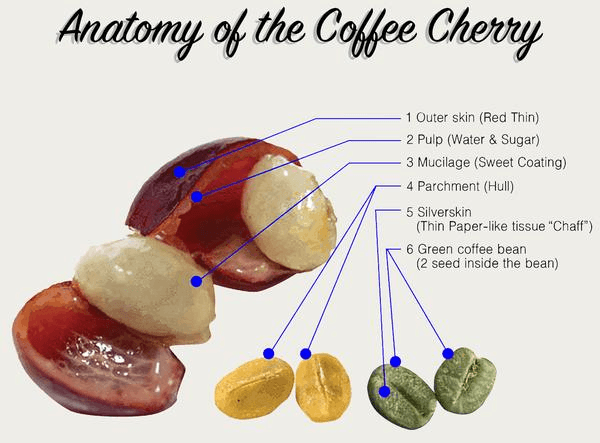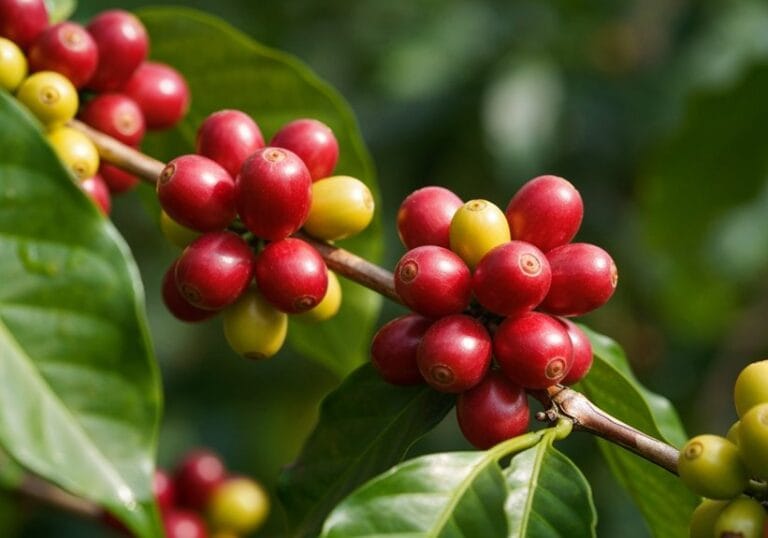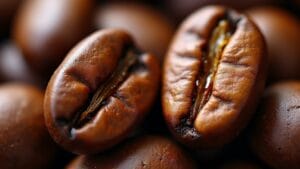So, guess what? Coffee is actually a fruit! Yep, it’s a berry called a coffee cherry! Who knew your morning cup of joe had such a glamorous backstory? These cherries come in red and purple hues, like they’re dressed for a party. Inside, they’re packed with two beans surrounded by tasty pulp—and a bit bitter, honestly. Who would’ve thought? And if you stick around, there’s plenty more juicy info about this delightful little cherried wonder!
Key Takeaways
- Coffee is classified as a fruit because it develops from the flowering plant’s ovary and contains seeds.
- The coffee fruit, known as “coffee cherry,” is technically a drupe, similar to cherries and olives.
- Coffee cherries exhibit colors ranging from red to purple, indicating ripeness and flavor potential.
- The fruit’s composition includes three layers: exocarp, mesocarp, and endocarp, each contributing to its structure.
- Coffee cherries have economic importance, as they provide livelihood for millions and are used in various products beyond brewing coffee.
Botanical Characteristics of Coffee Fruit
When you think about coffee, you might picture that steaming cup warming your hands on a chilly morning, but have you ever stopped to reflect that coffee is actually a fruit?
Yes, you heard that right—coffee is a berry! What is coffee cherry, you ask? Well, it’s the cheeky little name for the coffee fruit, which is technically a drupe.
These cherries can flaunt colors from red to purple, and they develop after fragrant white flowers bloom. But here’s the kicker: they taste more bitter than sweet. The fruit is known as a “coffee cherry,” a one- or two-seeded drupe that is an important part of coffee’s botanical identity.
Morphology and Composition of Coffee Cherries
Coffee cherries, those vibrant little orbs, pack a fascinating punch in their structure and composition!
Turns out, coffee beans are berries, and one can only marvel at what’s inside each cherry. Here are the key layers:
- Exocarp: This thin outer skin changes colors, signaling ripeness—like a genetic mood ring for coffee.
- Mesocarp: A sugary pulp that sweetens the deal, affecting flavor notes like citrus and caramel.
- Endocarp: The protective parchment layer that keeps those precious seeds safe, shielding them from all harm!
Inside, each cherry usually holds two beans, enveloped in a delicate silver skin.
This whole arrangement—how wild is that? It’s like nature’s own little coffee factory!
Economic Importance and Uses of Coffee Fruit

Many might think that coffee is just about those magical beans giving life to the daily grind, but wait—let’s not forget about the coffee cherry! This isn’t merely the cozy vessel for coffee beans; it’s a superstar in its own right!
For countless farmers, particularly in South America, coffee fruit means survival—over 25 million small producers rely on it! Picture it: Brazil alone has five million people tending to three billion of those luscious fruits!
And beyond the beans, coffee fruit serves up cascara tea, antioxidant snacks, and even fancy skincare. Talk about multitasking! All this not only enhances economies—coffee’s economic importance ripples worldwide—so next time you sip, remember the cherry behind your brew!
Genetic Background and Evolution of Coffee种
The journey of coffee’s genetic heritage is like a wild ride through the botanical rollercoaster park, and it all starts with the fascinating hybridization that created Coffea arabica. This coffee royalty is a mix, born from Coffea canephora and Coffea eugenioides, roughly 350,000 years ago!
So, it turns out:
- Is coffee a fruit? Yep, it comes from cherries!
- Arabica has the lowest genetic diversity of all major crops—talk about an exclusive club!
- Caffeine production has its own wild story, evolving independently—like coffee’s secret superhero origin.
Imagine a coffee plant with superhero traits, all thanks to its unique genes!
But, these traits make it vulnerable, so scientists are out there looking for solutions, immersing into the best of the best!
Frequently Asked Questions
Can Coffee Cherries Be Eaten Raw?
Coffee cherries can indeed be eaten raw. They possess a tangy, sweet flavor reminiscent of citrus and stone fruits. However, proper handling and washing are essential to prevent spoilage and potential foodborne illnesses.
How Should Coffee Cherries Be Stored?
Coffee cherries should be stored in cool, shaded, well-ventilated conditions to minimize spoilage. Once dried, they require moisture-proof packaging in temperature-controlled environments to maintain quality and prevent microbial growth during storage.
What Is Cascara, and How Is It Made?
Cascara is the dried husk and pulp of coffee cherries, produced after extracting the beans. It is made by drying the remaining fruit skins, often brewed into a tea with a fruity flavor profile.
Are Coffee Cherries Nutritious?
Coffee cherries are highly nutritious, containing significant amounts of dietary fiber, essential minerals, and antioxidants. Their composition supports multiple health benefits, making them a valuable addition to diets for those seeking nutrient-rich options.
What Climates Are Ideal for Coffee Cherry Cultivation?
Ideal climates for coffee cherry cultivation are tropical and subtropical regions located between the Tropics of Cancer and Capricorn, with stable temperatures, adequate rainfall, and appropriate altitude, facilitating superior growth conditions for both Arabica and Robusta varieties.
References
- https://edis.ifas.ufl.edu/publication/FP135
- https://en.wikipedia.org/wiki/Coffea_arabica
- https://en.wikipedia.org/wiki/Coffea
- https://sca.coffee/research/coffee-plants-of-the-world
- https://www.missouribotanicalgarden.org/PlantFinder/PlantFinderDetails.aspx?kempercode=b632
- https://www.britannica.com/plant/Coffea
- https://plants.ces.ncsu.edu/plants/coffea-arabica/
- https://ukersallaboutcoffee.wordpress.com/chapter15/
- https://gardeningsolutions.ifas.ufl.edu/plants/trees-and-shrubs/shrubs/coffee/





